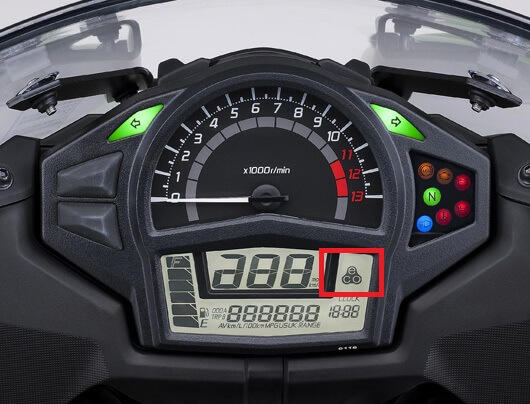The other day I introduced you toMotoBasic's Ninja 400 1 week review video.In the last issue, you reported the fuel consumption, and the figure was 25.4km/L (full tank method).
With a full tank, I can run 500km.It's a feeling. This is close to my feeling as well.......A while ago, it was ......
The current feeling is about 400km on a full tank: ........ That means 20% worse ........
The use of the bike itself hasn't changed that much. I travel around Tokyo for work on weekdays and tour 300-500km on weekends.
By the way, the Ninja 400's gauges have an eco indicator (official name: Economical Riding Indicator) in the area circled in red.

It lights up when you are driving with good fuel consumption efficiency, but basically"Pace at which you can run and check the meter slowly."The light is always on.
Is it because you changed the way you ride?
I've been able to go to more places of work where I can ride my bike little by little, and I think it's largely due to the fact that I've been doing more stop-and-go work in Tokyo on weekdays, but even if I fill up the tank in the morning and go out touring, I don't get as good mileage as I used to. The reason is probably this.
- High RPM
MotoBasic's video shows that the normal range for driving is around 4,000 rpm: ...... But since I've been touring with a big bike, I've been using 5,000rpm+α a lot. I don't know exactly what's going on, because Kawasaki hasn't released the engine performance curve for the Ninja 400, but I'm guessing that I'm using more and more rpm, which is not good for fuel economy.
- Extensive use of highways, speed range up
Basically, I like to drive slowly in the lane at 80-100km/h, but in winter when the sun sets early, my average speed tends to go up in order to spend more time touring in the light. I also use the Tokyo Metropolitan Expressway a lot these days to get around Tokyo, and I wonder if the bite of the engine has become tasty after 20,000 km or not.WAKO's Oilwas good, or was it?Fuel1I think the engine started to run better after the introduction of the two new engines in a row.
No, it's a seasonal factor, right?
And as I was writing this article, it occurred to me that ......Maybe it's because it's winter (i.e. cooler)?
When I googled it, I found out that this is also a major factor. It seems that this is also a big factor. The lower the temperature, the higher the oxygen density, and the more gasoline is consumed for combustion. Yeah, yeah. That makes a lot of sense.
Other suspected causes
- Maybe it's time to change the plugs?
The Ninja 400 is equipped with iridium plugs as standard, but what is the effect on fuel economy and longevity? A quick google search shows"To maintain the best combustion on a motorcycle with a high rotation speed, it is recommended to change every 20,000 km at a normal rotation speed of 5,000 rpm."So, I guess it's time to replace it.
By the way, the formula seems to be something like this.
Replacement time (10,000 km) = 10,000 ÷ Normal operating speed(rpm)
I don't care much about fuel economy, though......
It is a disadvantage that the frequency of gas station stops during the touring increases, especially at night in the countryside, there are few gas stations and I am in a hurry, but I am not too concerned about the fact that the fuel consumption itself has dropped. However, I don't really mind the fact that my fuel consumption is decreasing, mostly because of the way I ride. Even if you fill up the tank, it's only about 1,500 yen, which is cheap if you think of it as a fun fee for driving around.
The only thing I'm concerned about is the fact that running it in reverse will shorten the life of the engine.
The Ninja 400 has a multifunctional digital meter that displays instantaneous fuel consumption, so I'll try to see the difference at different RPMs.
Categories of this article:
diary
People who read this article also read


